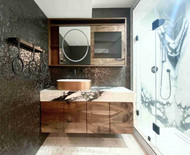Unleashing Tile Magic: Inspiring Shower Designs for Your Home
Posted by Mike Belk on Oct 20, 2023

The Beauty of Tile in Shower Designs
When it comes to shower designs, tile offers an array of possibilities to transform your bathroom into a stunning oasis. From the floor to the walls, tile can create a beautiful and functional space that suits your style and needs. In this section, we will explore the introduction to tile in shower designs and the benefits of using tile in showers.
Introduction to Tile in Shower Designs
Tile has been a popular choice for shower designs for many years, and for good reason. Its versatility and durability make it an excellent option for both functional and aesthetic purposes. Whether you prefer a sleek and modern look or a classic and timeless design, there is a tile that can help bring your vision to life.
With a wide variety of materials, colors, patterns, and textures available, you can create a shower space that reflects your personal style and complements the overall aesthetic of your bathroom. From ceramic and porcelain to glass and natural stone, the options are endless. Each type of tile brings its own unique characteristics and charm to the design.
Benefits of Using Tile in Showers
Using tile in showers offers several benefits that make it a popular choice among homeowners and designers alike. Here are some key advantages:
1. Water Resistance: Tile is highly resistant to water, making it an ideal choice for shower designs. Properly installed and sealed, tile helps prevent water from seeping through the walls and floors, protecting the structure of your bathroom.
2. Easy to Clean: Tile is relatively easy to clean, ensuring that your shower remains hygienic and free from mold and mildew. Regular maintenance, such as wiping down the tiles and grout, can help keep your shower looking fresh and beautiful.
3. Durability: Tiles are known for their durability and longevity. When properly cared for, they can withstand the daily wear and tear of a shower environment, maintaining their beauty for years to come.
4. Design Flexibility: With an extensive range of colors, patterns, and textures available, tile offers endless design possibilities. Whether you prefer a monochromatic look, a bold statement, or a mosaic masterpiece, tile allows you to create a shower design that suits your unique taste.
5. Value Addition: Incorporating tile in your shower design can increase the value of your home. A well-designed and well-maintained tile shower can be an attractive feature for potential buyers if you ever decide to sell your property.
By understanding the introduction and benefits of using tile in shower designs, you can make informed decisions when planning your bathroom renovation. In the next sections, we will explore various tile materials, creative patterns and layouts, color and texture options, as well as accent tiles and borders to further inspire your shower design.

Tile Materials for Shower Designs
When it comes to designing your shower, the choice of tile materials plays a significant role in achieving the desired aesthetic and functionality. Here are four popular options to consider: ceramic tiles, porcelain tiles, glass tiles, and natural stone tiles.
Ceramic Tiles
Ceramic tiles are a versatile and budget-friendly choice for shower designs. These tiles are made from clay and are available in a wide range of colors, sizes, and patterns. Ceramic tiles are known for their durability and resistance to water and stains, making them an excellent option for showers. They are also relatively easy to clean and maintain.
| Pros | Cons |
| Affordable | May chip or crack under heavy impact |
| Wide variety of colors and patterns | Not as durable as porcelain tiles |
| Water and stain-resistant |
Porcelain Tiles
Porcelain tiles are a popular choice for shower designs due to their exceptional durability and water resistance. These tiles are made from a refined clay mixture that is fired at high temperatures, resulting in a dense and non-porous material. Porcelain tiles come in various sizes, textures, and finishes, allowing for endless design possibilities. They are highly resistant to scratches, stains, and moisture, making them ideal for shower applications.
| Pros | Cons |
| Extremely durable | More expensive than ceramic tiles |
| Water and stain-resistant | Heavier and may require additional structural support |
| Wide range of sizes, textures, and finishes |
Glass Tiles
For a touch of elegance and visual appeal, glass tiles are an excellent choice for shower designs. These tiles are available in a variety of colors, shapes, and sizes, allowing for creative and unique patterns. Glass tiles can create a beautiful reflective surface, adding depth and brightness to your shower. They are resistant to water and stains and are relatively easy to clean. It's important to note that glass tiles can be more fragile compared to ceramic or porcelain tiles, so proper installation is crucial.
| Pros | Cons |
| Wide range of colors, shapes, and sizes | More expensive than ceramic or porcelain tiles |
| Reflective surface adds brightness and depth | Requires careful installation to avoid breakage |
| Resistant to water and stains |
Natural Stone Tiles
Natural stone tiles, such as marble, granite, or travertine, can bring a touch of luxury and sophistication to your shower. These tiles are available in various colors, patterns, and finishes, each with its unique characteristics. Natural stone tiles offer a timeless and elegant look, and their natural variations add depth and visual interest to your shower. It's important to note that natural stone tiles require regular sealing to maintain their beauty and protect them from moisture.
| Pros | Cons |
| Luxurious and timeless look | Requires regular sealing to prevent staining |
| Natural variations add depth and character | More expensive than other tile materials |
| Wide range of colors, patterns, and finishes | Requires proper maintenance and care |
Choosing the right tile material for your shower depends on your personal style, budget, and maintenance preferences. Whether you opt for the durability of ceramic or porcelain tiles, the elegance of glass tiles, or the natural beauty of stone tiles, each material offers its own unique charm. Remember to consider factors like water resistance, durability, and ease of maintenance when making your selection.
Creative Tile Patterns and Layouts
When it comes to designing a stunning shower, the choice of tile patterns and layouts can make a significant impact on the overall aesthetic. Here are a few creative tile patterns and layouts that can transform your shower into a work of art.
Classic Subway Tiles
Subway tiles are a timeless choice for shower designs. These rectangular tiles, typically measuring 3x6 inches, are laid in a horizontal brick pattern. The simplicity of this pattern provides a clean and elegant look that suits a variety of design styles. Subway tiles can be arranged in a traditional stacked layout or in a staggered brick pattern for added visual interest.
Herringbone Patterns
For those seeking a more intricate and visually captivating design, herringbone patterns are an excellent choice. This pattern involves arranging rectangular tiles diagonally in a V-shape, creating a zigzag effect. Herringbone patterns add a touch of sophistication and can make a small shower appear more spacious. This pattern works well with both large and small tiles, allowing for versatility in design.
Mosaic Designs
Mosaic tile designs offer endless possibilities to showcase your creativity. By using small tiles, you can create intricate patterns, pictures, or even depict scenes on the shower walls. Mosaic designs can be inspired by nature, geometric shapes, or abstract art, adding a unique and personalized touch to your shower. The wide range of colors and materials available for mosaic tiles allows you to achieve a truly custom look.
Geometric Shapes
To add a modern and contemporary touch to your shower, consider using geometric-shaped tiles. Hexagon, chevron, or diamond-shaped tiles can create a visually striking focal point. Mixing and matching different geometric shapes can result in a dynamic and eye-catching design. Geometric patterns can be subtle or bold, depending on the colors and contrasts chosen, making them a versatile option for any shower design.
By incorporating these creative tile patterns and layouts into your shower design, you can elevate the aesthetic appeal and create a unique space that reflects your personal style. Remember to consider the size and scale of the shower area, as well as the surrounding elements, to ensure a harmonious and cohesive design. For more inspiration, check out our article on subway tile ideas for bathroom.
Exploring Color and Texture
When it comes to tile shower designs, color and texture play a crucial role in creating the desired aesthetic and ambiance. The choices you make regarding color and texture can transform your shower into a stunning focal point. In this section, we will explore three different approaches: neutral tones, bold and vibrant colors, and textured tiles.
Neutral Tones for a Timeless Look
Neutral tones are a popular choice for shower designs, as they offer a timeless and elegant appeal. Shades of white, beige, gray, and taupe create a clean and sophisticated atmosphere in the bathroom. Neutral-colored tiles provide a versatile backdrop that can complement various design styles, from contemporary to traditional.
To add visual interest to a shower with neutral tiles, consider incorporating contrasting grout colors or decorative accents. These subtle touches can enhance the overall aesthetic while maintaining the elegance of the neutral tones.
Bold and Vibrant Colors for Personality
If you want to infuse your shower with personality and create a statement piece, consider using bold and vibrant colors. Bright blues, greens, oranges, and yellows can add a playful and energetic vibe to the bathroom. These bold colors can be applied to the entire shower area or used selectively as accent tiles to create a focal point.
When using bold colors, it's important to strike a balance and ensure that the overall design remains visually appealing. Pairing bold tiles with more neutral or complementary tones can help create a cohesive and harmonious look.
Textured Tiles for Added Depth
To create a visually dynamic and inviting shower, consider using textured tiles. Textured tiles add depth and dimension to the space, making it visually interesting and engaging. The textures can range from subtle patterns to more pronounced designs, such as 3D tiles or mosaic tiles with varying surface finishes.
Textured tiles not only enhance the visual appeal of the shower but also offer a tactile experience. The interplay of light and shadow on the textured surface can create a captivating effect.
By exploring different color schemes and textures, you can unleash the full potential of your tile shower design. Whether you opt for neutral tones, bold colors, or textured tiles, remember to consider the overall style of your bathroom and the atmosphere you want to create. With the right combination of colors and textures, your shower can become a true expression of your personal style and taste.
Accent Tiles and Borders
Incorporating accent tiles and borders can elevate the design of your shower, adding visual interest and defining focal points. By strategically placing these decorative elements, you can create a unique and personalized look for your bathroom.
Using Accent Tiles to Create Focal Points
Accent tiles are an excellent way to draw attention to specific areas within your shower. By using tiles with contrasting colors, textures, or patterns, you can create focal points that immediately catch the eye. These accent tiles can be placed in a vertical or horizontal band, as a decorative tile mural, or even as a border around a niche or seating area.
When choosing accent tiles, consider the overall style and color scheme of your bathroom. Opt for tiles that complement the surrounding tiles and enhance the overall aesthetic. Experiment with different tile shapes, sizes, and materials to find the perfect combination that adds personality and visual interest to your shower.
Incorporating Borders for Definition
Borders are another effective way to define and enhance the look of your shower. They can be placed at the top or bottom of the shower walls, around niches or alcoves, or even as a horizontal divider within the shower. Borders can be made from tiles of the same material as the rest of the shower walls, or you can choose contrasting tiles to create a striking visual effect.
Borders help to create a clean and defined look, making your shower design appear more polished and intentional. They can also serve as a transition between different tile patterns or materials, adding a touch of elegance and sophistication to the overall design. Consider using borders that complement the accent tiles or other design elements in your shower for a cohesive and cohesive look throughout the space.
Mixing and Matching Tiles for Visual Interest
For a truly unique and eye-catching shower design, consider mixing and matching different tiles. By combining tiles of various shapes, colors, textures, or patterns, you can create a visually dynamic and engaging shower space. The key to successful mixing and matching is to find a balance between the different elements, ensuring that they complement each other rather than clash.
Experiment with different combinations of tiles to create a design that reflects your personal style and preferences. You can mix subway tiles with mosaic tiles, or combine glass tiles with natural stone tiles for a striking contrast. The possibilities are endless, and the result will be a shower that is truly one-of-a-kind.
Accent tiles and borders provide creative opportunities to personalize your shower and elevate its design. By incorporating these elements, you can create focal points, define specific areas, and add visual interest to your bathroom space. Whether you choose to use accent tiles, borders, or a combination of both, remember to select tiles that harmonize with the overall style and color scheme of your shower for a cohesive and visually stunning result.
Tile Maintenance and Care
Once you've installed stunning tile in your shower, it's important to properly maintain and care for it to ensure its longevity and beauty. Regular cleaning and preventive measures help keep your shower tiles looking their best. Additionally, sealing the tiles can provide an extra layer of protection and enhance their durability. Here are some essential maintenance tips to keep in mind:
Cleaning and Preventing Mold and Mildew
Regular cleaning is essential to prevent the buildup of mold and mildew in your shower. These unsightly and potentially harmful substances can thrive in damp environments. To keep them at bay, follow these cleaning guidelines:
- Regularly clean your shower tiles using a mild, non-abrasive cleaner specifically designed for tile surfaces. Avoid harsh chemicals that can damage the tiles.
- Scrub the grout lines using a soft brush to remove any dirt or grime. Grout is porous and can easily accumulate dirt, making it a breeding ground for mold and mildew.
- Dry the shower area thoroughly after each use. This helps prevent moisture buildup and discourages mold growth.
- Use a squeegee to remove excess water from the tiles and glass surfaces. This simple step can significantly reduce the chances of mold and mildew formation.
For more detailed information on cleaning and preventing mold and mildew, check out our article on bathroom tile design ideas.
Sealing Tiles for Longevity
Sealing your shower tiles is an important step in maintaining their quality and appearance. The sealant acts as a protective barrier, preventing water, stains, and dirt from penetrating the tiles. Here are some key points to consider:
- Choose a high-quality sealant specifically formulated for the type of tiles you have installed in your shower. Different tile materials may require different types of sealants.
- Follow the manufacturer's instructions for the application of the sealant. Make sure to apply it evenly and cover the entire tile surface.
- Reapply the sealant periodically as recommended by the manufacturer. The frequency of resealing may vary depending on the tile material and the amount of use the shower receives.
Sealing your shower tiles can help maintain their original beauty and protect them from staining, discoloration, and damage caused by water and cleaning agents.
Regular Maintenance Tips
In addition to cleaning and sealing, there are a few other maintenance tips to keep your shower tiles in top condition:
- Wipe up spills and stains promptly to prevent them from settling into the tiles or grout lines.
- Avoid using abrasive cleaners or tools that can scratch or damage the tiles.
- Inspect the grout lines regularly and repair any cracks or gaps to prevent water infiltration and potential tile damage.
- Avoid using excessive force when cleaning or scrubbing the tiles, as this can cause chipping or cracking.
By following these maintenance tips, you can ensure that your shower tiles remain beautiful and functional for years to come. Taking care of your tiles not only preserves their appearance but also helps maintain the overall cleanliness and hygiene of your shower space.



